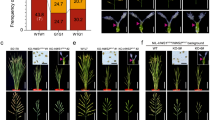Abstract
Triticale hexaploide, the intergeneric hybrid resulting from the cross of diploid rye (Secale cereale) and tetraploid wheat (Triticum durum), offers a unique opportunity for the study of the expression of genes which are derived from two dissimilar organisms but exist together in the same cells. I have investigated the expression of histone genes in triticale because the histones are an extensively studied class of proteins with individual components which range from being highly conservative in an evolutionary sense to being probably species specific. For example, the sequence of histone F2a1 from peas and cows differs in only two of 102 amino acids1, whereas different species of sea urchin have F1 histones of different electrophoretic mobilities2. I have found that in wheat, rye and triticale the evolutionarily conservative histones seem to be identical. There are, however, differences in the F1 histones of wheat and rye, and the gene for one of the wheat F1 histones is not expressed in the hybrid triticale.
This is a preview of subscription content, access via your institution
Access options
Subscribe to this journal
Receive 51 print issues and online access
$199.00 per year
only $3.90 per issue
Buy this article
- Purchase on Springer Link
- Instant access to full article PDF
Prices may be subject to local taxes which are calculated during checkout
Similar content being viewed by others
References
DeLange, R. J., and Smith, E. L., J. Rev. Biochem., 40, 279–314 (1971).
Easton, D. P., Chamberlain, J. P., Whitely, A. H., and Whitely, H. R., Biochem. biophys. Res. Commun., 57, 513–519 (1974).
Spiker, S., and Krishnaswamy, L., Planta, 110, 71–76 (1973).
Panyim, S., and Chalkley, R., Archs Biochem. Biophys., 130, 337–346 (1969).
Johns, E. W., Biochem. J., 92, 55–59 (1964).
Alfageme, C. R., Zweidler, A., Mahowald, A., and Cohen, L. H., J. biol. Chem., 249, 3729–3736 (1974).
Sherod, D., Johnson, G., and Chalkley, R., Biochemistry, 9, 4611–4615 (1970).
Author information
Authors and Affiliations
Rights and permissions
About this article
Cite this article
SPIKER, S. Expression of parental histone genes in the intergeneric hybrid Triticale hexaploide. Nature 259, 418–420 (1976). https://doi.org/10.1038/259418a0
Received:
Accepted:
Issue Date:
DOI: https://doi.org/10.1038/259418a0
This article is cited by
-
Onset of grain filling is associated with a change in properties of linker histone variants in maize kernels
Planta (2010)
-
Histones of the cotton plant. Molecular characteristics of histone H1
Chemistry of Natural Compounds (1986)
-
Coexpression of species-specific histone H1 and H2B genes in mouse-rat hybrid cells
Somatic Cell Genetics (1982)
-
Expression of H1 histone genes in mouse-human somatic cell hybrids
Somatic Cell Genetics (1980)
Comments
By submitting a comment you agree to abide by our Terms and Community Guidelines. If you find something abusive or that does not comply with our terms or guidelines please flag it as inappropriate.



